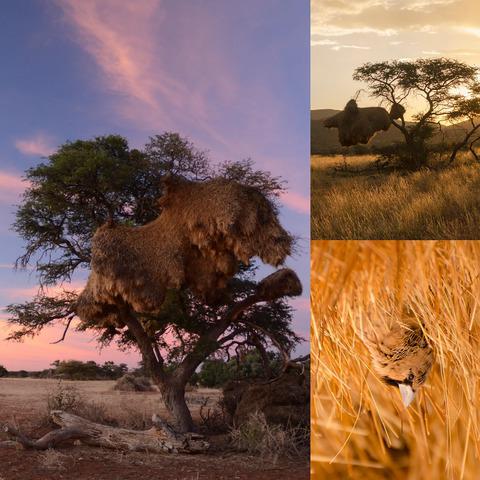当前位置:
X-MOL 学术
›
Ecol. Evol.
›
论文详情
Our official English website, www.x-mol.net, welcomes your feedback! (Note: you will need to create a separate account there.)
Faunal input at host plants: Can camel thorn trees use nutrients imported by resident sociable weavers?
Ecology and Evolution ( IF 2.6 ) Pub Date : 2020-09-21 , DOI: 10.1002/ece3.6798 Kervin D. Prayag 1 , Carla J. Toit 1, 2 , Michael D. Cramer 1 , Robert L. Thomson 1, 2
Ecology and Evolution ( IF 2.6 ) Pub Date : 2020-09-21 , DOI: 10.1002/ece3.6798 Kervin D. Prayag 1 , Carla J. Toit 1, 2 , Michael D. Cramer 1 , Robert L. Thomson 1, 2
Affiliation

|
“Islands of fertility” result from the focussing of water and nutrients around many shrub or tree species due to plants foraging for resources. Plant–animal feedbacks may amplify the development of such islands through environmental modification due to, for example, faunal deposition of nutrients and seeds. Fauna residing within vegetation clumps are likely to exert stronger feedbacks on their hosts than itinerant species. We studied the interaction between camel thorn trees (Vachellia erioloba) and the colonial nests of sociable weavers (Philetairus socius) in the Kalahari. We hypothesized that the accumulation of biological material below the nests will alter the nutrient status of the soil beneath the nest trees, in relation to unoccupied trees and the surrounding grassland. We also suggested that this association will have both positive and negative effects on the camel thorn trees. We found that soil concentrations of N, P, and K were, respectively, 4, 4.6, and 1.2 times higher below trees with nests compared to control trees, indicating faunal concentration of nutrients. Soil δ15N values were higher below trees with nests than below control trees without nests. Foliar δ15N values were also higher in nest trees than in control trees, showing the trees accessed faunally derived N. Furthermore, foliar biomass per diameter of terminal branches was 27% higher in nest trees, suggesting that trees respond to nutrient input from the weavers with increased growth. Large barren areas in the subcanopy vegetation directly beneath the colonies were attributed to decreased water infiltration rates, as a result of accumulation of organic matter due to continuous deposition of feces, possibly limiting competitive species from establishing in the subcanopy. On the other hand, canopy volume was reduced in trees with nests due to nests occupying large volumes within the canopy, and nests frequently causing branch fall, indicating costs associated with hosting weaver colonies. Synthesis: We found nutritional benefits to camel thorn trees when hosting sociable weaver colonies. These benefits can potentially overcome important environmental constraints, but these are partially offset by the resulting costs to the host trees.
中文翻译:

寄主植物的动物投入:骆驼刺树可以使用当地居民的编织者进口的养分吗?
“肥沃的岛屿”是由于植物寻找资源而将水和养分集中在许多灌木或树种周围的结果。植物-动物的反馈可能会由于环境变化(例如,营养物质和种子的动植物沉积)而扩大此类岛屿的发育。居住在植被丛中的动物可能比动植物物种对寄主的反馈更强。我们研究了骆驼刺树(Vachellia erioloba)和交织的织布工(Philetairus socius)的殖民巢穴之间的相互作用。)在卡拉哈里。我们假设,相对于空置的树木和周围的草地,巢穴下生物物质的积累会改变巢穴树下土壤的营养状况。我们还建议,这种关联将对骆驼刺树产生积极和消极的影响。我们发现,与对照树相比,有巢的树下的土壤氮,磷和钾的浓度分别高4倍,4.6倍和1.2倍,表明动物的养分含量较高。土壤δ 15个N个值而不巢低于与巢比低于控制的树木更高。叶面δ 15巢树中的N值也比对照树中的高,这表明树木从动物区系中获得了氮。此外,巢树中每末端直径的叶生物量高出27%,这表明树对织布机养分输入的反应随着增长。菌落正下方菌落的大面积贫瘠区域归因于水的渗透率降低,这是由于粪便不断沉积导致有机物积累,可能限制了竞争物种在亚菌盖中的建立。另一方面,由于巢在树冠内占据较大的体积,因此带有巢的树中的树冠体积减小了,并且巢经常导致分支倒下,这表明与寄主织布者殖民地相关的成本。合成:我们发现在托管社交织布者殖民地时,骆驼刺树具有营养价值。这些好处可以潜在地克服重要的环境限制,但是这些因宿主树的成本而被部分抵消。
更新日期:2020-10-29
中文翻译:

寄主植物的动物投入:骆驼刺树可以使用当地居民的编织者进口的养分吗?
“肥沃的岛屿”是由于植物寻找资源而将水和养分集中在许多灌木或树种周围的结果。植物-动物的反馈可能会由于环境变化(例如,营养物质和种子的动植物沉积)而扩大此类岛屿的发育。居住在植被丛中的动物可能比动植物物种对寄主的反馈更强。我们研究了骆驼刺树(Vachellia erioloba)和交织的织布工(Philetairus socius)的殖民巢穴之间的相互作用。)在卡拉哈里。我们假设,相对于空置的树木和周围的草地,巢穴下生物物质的积累会改变巢穴树下土壤的营养状况。我们还建议,这种关联将对骆驼刺树产生积极和消极的影响。我们发现,与对照树相比,有巢的树下的土壤氮,磷和钾的浓度分别高4倍,4.6倍和1.2倍,表明动物的养分含量较高。土壤δ 15个N个值而不巢低于与巢比低于控制的树木更高。叶面δ 15巢树中的N值也比对照树中的高,这表明树木从动物区系中获得了氮。此外,巢树中每末端直径的叶生物量高出27%,这表明树对织布机养分输入的反应随着增长。菌落正下方菌落的大面积贫瘠区域归因于水的渗透率降低,这是由于粪便不断沉积导致有机物积累,可能限制了竞争物种在亚菌盖中的建立。另一方面,由于巢在树冠内占据较大的体积,因此带有巢的树中的树冠体积减小了,并且巢经常导致分支倒下,这表明与寄主织布者殖民地相关的成本。合成:我们发现在托管社交织布者殖民地时,骆驼刺树具有营养价值。这些好处可以潜在地克服重要的环境限制,但是这些因宿主树的成本而被部分抵消。


























 京公网安备 11010802027423号
京公网安备 11010802027423号